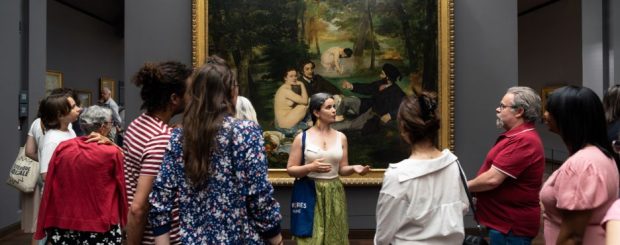The Musée d’Orsay is one of the most famous museums in Paris
The Musée d’Orsay is one of the most famous museums in Paris, France. It is located in a beautiful Beaux-Arts building that was once a railway station, and it houses an impressive collection of art from the 19th and early 20th centuries. In this article, we will take you on a guided tour of the Musée d’Orsay, highlighting some of the museum’s most notable works and exhibits.
The museum’s collection
The museum’s collection is divided into several departments, including painting, sculpture, decorative arts, and photography. The painting department is perhaps the most famous, with works by some of the most renowned artists of the 19th and early 20th centuries.
One of the most significant works in the museum’s painting department is Gustave Courbet’s “The Origin of the World.” This provocative painting depicts a close-up of a woman’s genitals, and it caused quite a scandal when it was first exhibited in 1866. Today, it is considered a masterpiece of realist painting.
Another notable work in the painting department is Édouard Manet’s “Olympia.” This painting, which was also quite scandalous when it was first exhibited in 1865, shows a nude woman reclining on a bed while a servant brings her a bouquet of flowers. The painting is considered a pivotal work in the development of modern art, and it continues to fascinate and inspire viewers today.

The museum’s sculpture department is also worth a visit.
It includes works by Auguste Rodin, Camille Claudel, and other important sculptors of the 19th and early 20th centuries. One of the most striking works in this department is Rodin’s “The Kiss,” which depicts a passionate embrace between a man and a woman.
The decorative arts department features a wide range of objects, including furniture, ceramics, and glassware. One of the highlights of this department is a collection of art nouveau furniture and decorative objects, which are characterized by their flowing, organic forms and naturalistic motifs.
Conclusion
The museum’s photography department includes a collection of over 40,000 photographs, ranging from early daguerreotypes to contemporary works. Some of the most notable photographers represented in the collection include Eugène Atget, Henri Cartier-Bresson, and Man Ray.
In addition to its permanent collection, the Musée d’Orsay also hosts a number of temporary exhibitions throughout the year. These exhibitions often focus on specific artists, movements, or themes, and they provide a fascinating glimpse into different aspects of 19th and early 20th century art.
Overall, the Musée d’Orsay is a must-visit destination for anyone interested in art and culture. Its impressive collection, stunning architecture, and central location make it one of the most popular museums in Paris, and a highlight of any visit to the city.
Book: Paris: Musée d’Orsay Guided Tour with Options
Musee d’orsay Frequanty Asked Questions
What is the Musée d’Orsay?
The Musée d’Orsay is a museum in Paris, France, located in the former Gare d’Orsay railway station. It houses a collection of French art from the mid-19th century to the early 20th century, including paintings, sculptures, furniture, and photography.
What are the Musée d’Orsay’s hours of operation?
The Musée d’Orsay is open Tuesday to Sunday from 9:30 a.m. to 6:00 p.m. (last entry at 5:00 p.m.). It is closed on Mondays, as well as on certain holidays such as Christmas Day and New Year’s Day.
How can I buy tickets for the Musée d’Orsay?
Tickets for the Musée d’Orsay can be purchased online on the museum’s official website or in person at the museum. It is recommended to purchase tickets in advance online to avoid long lines.
How much does it cost to visit the Musée d’Orsay?
The price of admission varies depending on the type of ticket and the age of the visitor. As of 2023, the regular price for an adult is €16, while reduced admission is available for visitors under 26, teachers, and certain other groups. Admission is free for children under 18 and EU citizens under 26.
Can I take photographs in the Musée d’Orsay?
Photography is allowed in most areas of the Musée d’Orsay, except for some temporary exhibitions where photography may be prohibited. Flash photography and the use of tripods or selfie sticks are not allowed.
Is the Musée d’Orsay accessible for visitors with disabilities?
Yes, the Musée d’Orsay is accessible for visitors with disabilities. The museum has elevators, ramps, and accessible restrooms, as well as tactile maps and audio guides for blind and visually impaired visitors. Personal assistants are admitted free of charge.
Are there guided tours available at the Musée d’Orsay?
Yes, guided tours are available at the Musée d’Orsay. They can be booked online or in person at the museum. The museum also offers audio guides in several languages.
Is there a coat check at the Musée d’Orsay?
Yes, there is a coat check at the Musée d’Orsay where visitors can leave their coats, umbrellas, and large bags. The coat check is located near the main entrance.
Are there any restaurants or cafes at the Musée d’Orsay?
Yes, there are several restaurants and cafes at the Musée d’Orsay, including a cafe on the ground floor, a restaurant on the top floor, and a cafe in the museum’s garden. There are also vending machines for drinks and snacks throughout the museum.
What is the best way to get to the Musée d’Orsay?
The Musée d’Orsay is located in the 7th arrondissement of Paris and is easily accessible by public transportation. The closest metro station is Solférino (line 12), and several bus lines also stop near the museum. Visitors can also take a taxi or walk to the museum from nearby attractions such as the Louvre or the Tuileries Garden.












